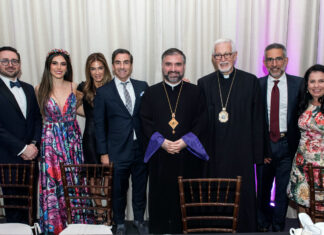LISLE, ILL. – George G. Markarian, MD, age 88, a longtime resident of Lisle, passed away on November 22. He was born on May 15, 1932 in Tabriz, Iran.
Dr. Markarian is survived by his wife of 58 years, Larissa Markarian (nee Bagratuni), sons Gregory George Markarian, MD and Michael George Markarian; grandchildren Farrah Elena Markarian and Joseph Hideki Markarian; siblings Hrand Markarian and Angie Demers-Markarian, MD; niece and nephew Pierre Demers and Helen Demers. He is preceded in death by his parents and Paranjem and Bartough Markarian; his sister Goharik Markarian.

Dr. George Markarian was the son of Armenian immigrant parents who fled Soviet Armenia to Iran to escape communist persecution. After three years, his family moved to Tehran, where he grew up. He was an extremely gifted soccer player and also very talented academically. As he grew up, his talents in academics and soccer grew immensely. By the time he was 17, he was admitted to the Iranian National team as its star center forward and also shortly thereafter he was admitted to the University of Tehran medical school.
His medical career ran in parallel with a phenomenal soccer career. As captain of the national team he led the 1951 Iranian squad to a silver medal in the Asia Olympic Games (Asian Cup). He was also the premier center forward for the top club team in Iran called Taj. This team annually finished number one in the Iranian league while he was a member. He played alongside other Iranian greats like Khatemi, Boyuk Jedikar, and Mahmoud Bayati. Dr. Markarian also started a medical school university team that finished first in Iran six straight years while he was playing.
He often had to play multiple games on the same day because at that time he played for three teams and would sometimes go from one game to another on the same day. He was a prolific scorer and while records were not kept in that era, he would often score multiple goals per game whether it be for the national team, Taj or the medical school team. One example was a day he had two games with the first game in the morning for the medical school where he scored five goals and then later that evening he scored 3 goals for the Taj club in the Iranian league.
In 1956 Iran was playing their very important rival Iraq. Before that match Dr. Markarian was engrossed in his medical studies and informed the national team he could not play for the match because the training would interfere with his preparation for his medical school exams. When the Shah of Iran learned of this and realized how important George’s role would be to have success in such an important match, he contacted his professor and made arrangements for George’s exams to be delayed. Also, the Shah had Dr. Markarian stay at his palace and study and train for the match on his private soccer field within the palace grounds. The Shah’s strategy reaped rewards against a very tough and talented Iraq squad as Iran defeated Iraq 4-3. Dr. Markarian scored 3 goals including the game winner and had a perfect assist for Iran’s second goal of the match which was a long cross outside the penalty area near the corner flag to the head of Nader Afshar (second goal of the match).










